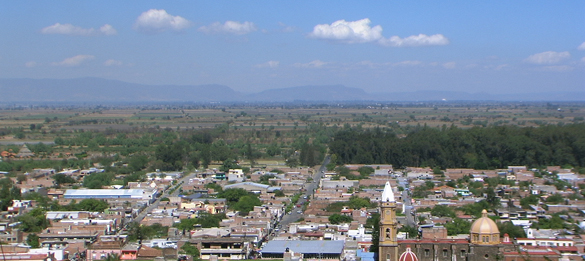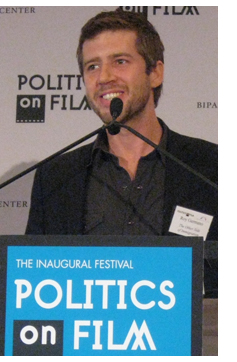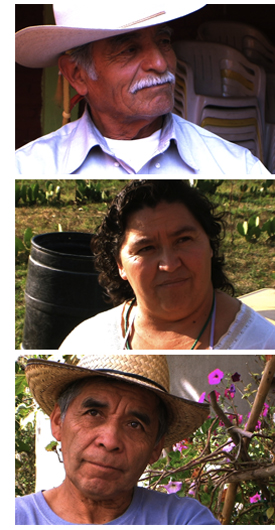| Sun | Mon | Tue | Wed | Thu | Fri | Sat |
|---|---|---|---|---|---|---|
| 1 | 2 | 3 | 4 | 5 | ||
| 6 | 7 | 8 | 9 | 10 | 11 | 12 |
| 13 | 14 | 15 | 16 | 17 | 18 | 19 |
| 20 | 21 | 22 | 23 | 24 | 25 | 26 |
| 27 | 28 | 29 | 30 | 31 |
CATEGORIES
RECENT ENTRIES
BLOG ROLL
Maroon Lens: Roy Germano
Maroon Lens is an occasional column about alumni filmmakers. In this installment, political scientist-cum-filmmaker Roy Germano, AM'03, explores Mexican immigration from both sides of the border.
By Ruth E. Kott, AM'07

In 2008, while Roy Germano, AM'03, was getting his doctorate at the University of Texas at Austin, he filmed a documentary about Mexican immigration to the United States—the economic and social reasons that people leave their home cities and what happens to those left behind. "The problem is the lack of opportunities in the Mexican countryside," one man says in the film.
"I can't make it here," another man argues, "so I have to work in the US." The winner of the 2011 American Library Association Notable Video Award, The Other Side of Immigration has been screened at more than 50 film festivals and university events. Germano, now a visiting assistant professor at UT, has become a popular interview subject on US and Spanish-speaking news networks.

Why did you make a documentary in addition to a written dissertation?
My first introduction to the immigration issue came in 2003, when I worked as a waiter while finishing my master's thesis at U of C. Many of my coworkers at the restaurant—the cooks, the busboys, the dishwashers—were undocumented immigrants from Mexico. Their stories about why they left home to work illegally in the United States inspired me to learn more about the root causes of Mexican immigration.
I enrolled in a PhD program at the University of Texas at Austin and spent much of next three years doing fieldwork in the Mexican countryside. The more research I did in Mexico, the more convinced I became that a deeper understanding of the factors that motivate undocumented immigration could help us design better immigration policies. The challenge for me then was to find a way to make this kind of information accessible to policymakers and the public. My dissertation wouldn’t do the trick. One day it dawned on me that I should try to make a documentary.
What kind of documentary-making experience did you have before making The Other Side of Immigration?
Not very much. My experience was basically limited to some video-production courses I took in high school. But I realize now how valuable those early experiences were. This was 15 years ago—before powerful laptops, digital video, and nonlinear editing software became ubiquitous. I believe that originally learning to edit linearly on tape taught me some important lessons about the fundamentals of editing and nonfiction filmmaking—lessons that I applied and built from when making The Other Side of Immigration.
How did you find your subjects?
I shot most of the film in early 2008 while collecting quantitative data for my dissertation. My research team and I were in the field for about a month, and we surveyed more than 700 households in ten Mexican towns with extremely high rates of out-migration. Along the way I met dozens of individuals—farmers, return migrants, community leaders, and relatives of people who had gone to the United States—who were willing to tell their stories on camera.
How much time did you spend shooting and editing?
Filming lasted about two months. Editing was slow because I had a lot of work to do in developing my technical and storytelling skills. And I was working on the project alone. Lots of 16-hour days with the other eight spent dreaming about the next day’s editing. I submitted a cut to some film festivals after about five months of editing. None were interested. I thought about abandoning the project at that point, but instead decided to start over and completely re-edit the film. The subsequent cut fared much better. But even after the film premiered at the Las Vegas Film Festival in April 2009, a year after I finished shooting, I continued editing for about another year between festivals and university screenings, tweaking things here and there until I finally felt ready to lock in a cut in for the DVD.
What was the most challenging part of making the film?
The entire undertaking was pretty challenging. Money was definitely an issue. I funded the film with my own savings while living on a $14,000-a-year grad-student salary. That made it impossible to hire a crew or buy fancy equipment. There was a steep learning curve for certain tasks, like translation and subtitling (most of the film is in Spanish). And there was always pressure to keep up with dissertation writing. But looking back, I wouldn’t trade the experience. The process taught me countless lessons and proved to me that I am capable of stretching a dollar and producing a solid film under less-than-ideal circumstances.

Were there any particularly memorable moments?
Just about every interview I conducted was a memorable experience. The people I met in the Mexican countryside were extremely articulate and full of pragmatic insights about this complex issue. They are the true immigration experts. Their eloquence and insights really come across in the film. This tends to surprise some people, I think because so many Americans grow up with the false notion that Mexicans are not articulate or insightful people. But these are just the types of stereotypes I hope the film can play some role in breaking down.
Why do you think it’s important to spread this message now?
Anti-immigrant sentiment is at its highest level in a century, and the mainstream media play a significant role in perpetuating myths that immigrants are criminals or here to have anchor babies. So what are Americans to believe if this is the primary way they get information about immigrants? Since I’ve had the opportunity to learn so much about this issue, I feel a responsibility to do what I can to counter the myths. With a deeper understanding of the issue, I think many Americans would identify with, if not admire, those who make the very difficult and risky decision to migrate illegally. In itself, empathy and understanding are not policy solutions. But I think empathy and understanding are the first steps in imagining immigration policies that serve everyone better, citizens and immigrants alike.
Have you run into any hostility over the course of the interviews you've done about the film?
My interviews with Fox News and Telemundo occurred within about an hour of one another. It was interesting to go from one studio to the other, since the two networks tend to present such different perspectives on immigration. But in both cases, everyone was completely professional, and I feel fortunate to have been able to reach such diverse audiences in the same day.
I also had the opportunity to speak with acclaimed journalist Jorge Ramos of Univision recently. I admire him a lot, so it was a big honor to be invited to his show. Although people of all backgrounds and political stripes attend my screenings and speaking engagements, there is rarely any hostility. The film avoids ideological arguments. It is not a left-wing film or a right-wing film. For me, the goal is putting the research out there so people can learn something new and make informed opinions.
Talk about your next project and how it relates to your first film.
While The Other Side of Immigration focuses entirely on Mexico, my next documentary will look more at border issues and immigration policy from the US perspective. I’m interested in making another film about immigration because, again, I think there are still a lot of stories and information that don’t make it into the mainstream media or our policy debate. I’m planning to make a big announcement in the coming months with more details about the next film.
March 24, 2011
